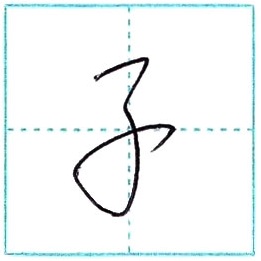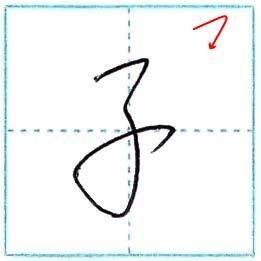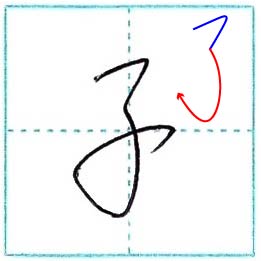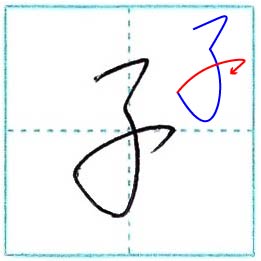今回は、草書の「子」です。
こんかいは、そうしょの「子(し)」です。
This time is 子(shi) in cursive script.

スポンサーリンク
この文字は、行書と草書の形がよく似ています。このように画数が少ない漢字では、行書と草書の区別がつきにくい場合があります。
このもじは、ぎょうしょとそうしょのかたちがよくにています。このようにかくすうがすくないかんじでは、ぎょうしょとそうしょのくべつがつきにくいばあいがあります。
This letter is very similar in semi-cursive and cursive. Like this, in the case of kanji with only a few strokes, it’s sometimes hard to distinguish the two styles.
単語例(たんごれい)
Word examples
息子 [むすこ musu ko] = son
子供 [こども ko domo] = child
親子 [おやこ oya ko] = parent and child
双子 [ふたご futa go] = twin
迷子 [まいご mai go] = lost child
子音 [しいん shi in] = consonant
遺伝子 [いでんし i den shi] = gene
菓子 [かし ka shi] = confectionery
調子 [ちょうし chou shi] = tune, condition
子午線 [しごせん shi go sen] = the meridian
利子 [りし ri shi] = interest
弟子 [でし de shi] = disciple
帽子 [ぼうし bou shi] = hat, cap
椅子 [いす i su] = chair
扇子 [せんす sen su] = folding fan
様子 [ようす you su] = state, appearance
種子島 [たねがしま tane ga shima] = Tanegashima Island in Japan
餃子 [ぎょうざ gyou za] = gyoza (Chinese dumpling)
スポンサーリンク
書き順(かきじゅん)
Stroke order
1. この文字は、1画で書きます。
このもじは、いっかくでかきます。
Write this letter with one stroke.
1-1.

1-2.

1-3.

2. 完成(かんせい) Finish

公開日/post 2016.12.14
更新日/update 2021.04.09
スポンサーリンク
